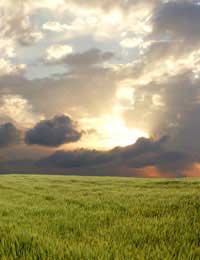Predicting the Weather

Being able to predict the weather in any kind of outdoor pursuit is a useful skill to learn. It can make all the difference to the enjoyment of your chosen activity and in extreme cases; it can even mean the difference between life and death. By understanding atmospheric pressure, how to read the clouds and through a basic knowledge of how wildlife and your surrounding environment react to impending changes in the weather, you can take the necessary action to avoid trouble and to keep safe.
Reading the Clouds
At a very basic level, white clouds indicate a fine day and the higher they are, the better the weather is likely to be. Storm clouds are usually black and low and often combine together to form one large mass of cloud. This means that rain is fast approaching and it’s time to take shelter. Although this is something that most of us are able to observe and recognise from quite an early age, the key to predicting the weather in a survival situation is how soon we’re able to spot the signs and how long we anticipate any adverse weather to last.For example, a large, oncoming storm will make its presence felt over a long period. There will be a noticeable increase in cloud activity and the wind will often change direction rapidly. Smaller storms give less warning and will rush in quickly, then rush out again. A useful way of determining what kind of storm is approaching is to think “wind then rain” or “rain then wind”. If rain starts to fall yet there’s little change in wind intensity, it’s likely to mean that the storm will be much longer and stronger. Adversely, wind followed by rain signals a much smaller storm that is likely to pass through quite quickly.
The Direction of Temperature
Most of us consider temperature in simple terms of the weather getting hotter or colder but in outdoor survival, the directional trends in temperature can also help us predict the likelihood of the kind of weather we can expect. We’re all used to the common trend of temperatures rising and warming the planet as the day progresses, peaking around the hours of noon until 3pm, then slowly cooling as the afternoon wanes and dusk starts to fall. But certain quirks and deviations do occur. For example, if the temperature seems to be dropping steadily even though the sun is still rising in the morning sky, it tends to indicate that a cold, dry front is moving in whilst temperatures which seem to rise when you wouldn’t expect them to can mean that rain is on the way.Red Sky
We’re all very familiar with the phrase “red sky at night, shepherd’s (or sailor’s) delight, red sky in the morning, shepherd’s warning” which makes it easy to remember that a red sky as dusk falls signals that the next day is likely to be sunny and dry. This is because the sun is shining through dust particles which are pushed ahead of a high pressure system which is bringing dry air in with it. A red sky at dawn is a warning of the impending arrival of a low pressure system bringing in moisture and rain or maybe even a storm. Remember not to confuse a red sky in the morning with a red sun. Even if the sun is red, it is likely to still be a fine day as long as the sky is its usual colour.Observing Nature and the Environment
Looking around our environment often gives us clues to the forthcoming weather. Any birds that mainly thrive on insects will fly much lower to the ground if rain is fast approaching. If you’ve built a campfire, the smoke from it should rise steadily in fine weather but if it starts descending or swirling around it’s a signal that low pressure and therefore rain, is on the way. It’s not only what you see that helps in your weather predictions – your other senses play a part as well. Sounds of nature, particularly bird sounds will be audibly clearer when rain is approaching and the air will begin to smell much fresher and cleaner just prior to rainfall.There are also plenty of useful little devices you can make using water, glass and other tools to help you predict the weather but having an intuitive sense of how to recognise weather signs and what they mean will help you on your way and can make all the difference in a survival situation.
Business energy with a difference
Looking for better business energy options? Whether it’s advanced monitoring, new connections, or adjusting capacity, our sponsor, Purely Energy can help.
📞 Call 0161 521 3400 or simply send us your details below for a no-obligation chat.
Sponsored by Purely Energy
Purely kindly sponsors this site. They help businesses deal with all aspects from securing the lowest prices, capacity upgrades, usage monitoring using their proprietory software, Purely Insights, and many other aspects. Need help with your commercial energy? Enter your details below and they’ll get back to you.
- Cold Weather Survival
- The Boy Scout Handbook and Survival
- Using the Stars to Navigate
- Surviving a Chemical Attack
- Dangers and Benefits of Leeches
- Surviving in the Desert
- Intestinal Parasites and Diarrhoea
- How to Communicate With the Locals
- Preventing and Treating Snake Bites
- How To Survive A Forest Fire
- How to Get Out Of A Mud Bog (Quicksand)
- Handling An Evacuation Procedure
- Prepare to Stay Over Night
- How to Cross Rivers, Streams and Rapids
- Surviving at Sea
- How To Survive Worst Case Scenarios
- Surviving an Animal Attack
- Surviving Natural Disasters
- Dealing with Insects in a Survival Situation
- Dealing With Children in a Survival Situation
- Predicting the Weather
- Preventing and Treating Frostbite
- Survival Psychology
- Surviving in Extreme Heat



